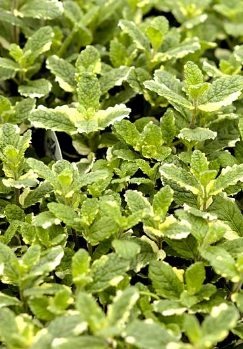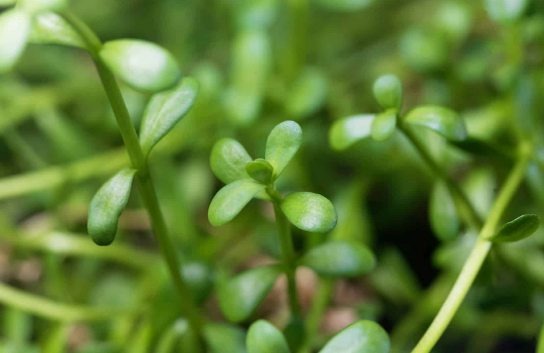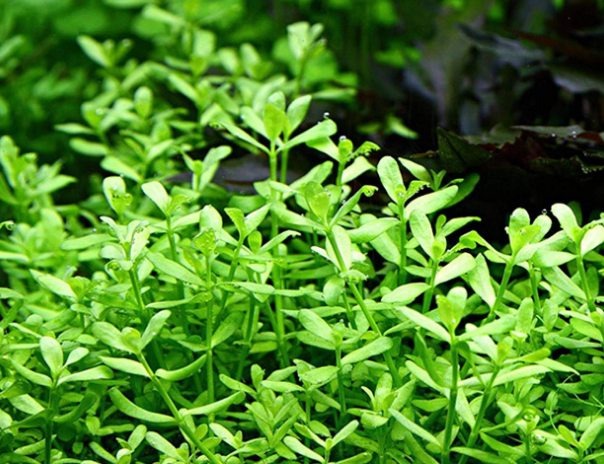How to Grow & Care for Moneywort (Bacopa Monnieri)
Written by Ivy
Dec 30 2022

A tropical freshwater plant called moneywort is perfect for beginning aquarists.
They are so well-liked because of how simple and versatile they are to maintain. This plant can be positioned in various spots around the aquarium to produce a lovely landscape.
Because of their similarities, however, these two plants are frequently confused.
Learn everything there is to know about moneywort, including how to take care of the plant, which fish go well with it, how to propagate it, and much more, by reading on.

Distribution & Natural Habitat
Moneywort is a plant that grows throughout the tropics and in the southern US, Asia, Africa, India, and Australia. It is typically found in some brackish areas, some woodland areas, the edges of freshwater marshes and wetlands, and other places. At least four nations consider it to be an invasive species.
It's a creeping herb that grows in thick mats and "creeps" over mud and sand, rocks, trees, and anything else in its path. It rarely, if ever, grows in water that is deeper than one foot and prefers to avoid it.
How to Plant Moneywort
Even though moneywort doesn't need a specific substrate, aquarium soil is where it grows best.
Although it will be challenging to plant because of its propensity to float, you can also grow this plant in gravel or sand. Regardless of the substrate you choose, it is best to secure the plant using aquarium tweezers. To hold the plant in place, you can add small rocks or pebbles.
Simply check that the roots are firmly anchored in the substrate at a depth of 0.5 to 1 inches when planting the individual plants. Additionally, make sure they are at least 2 inches apart.
Keep them as a floating plant if you'd rather.
There is very little preparation required for this.
Just carefully separate the stems and let them float freely on the water's surface. Additionally, you can take some cuttings from the young plant and float them to encourage the development of new roots. This might also encourage the original plant's stem to produce another stem.
Just make sure that any plant species below will still receive enough light if you intend to make this a floating plant. The shade cast by the floating moneywort may prevent the majority of light from penetrating the tank's bottom depending on the density of the surrounding material.
How to Care for Moneywort
Tank Requirements
As with all new plants, your first task is to check that your tank is configured properly.
The water parameters and lighting are the most critical variables to watch.
This ensures that after the plant is placed, there will be remaining swimming space for your fish. Your aquarium must be at least 10 gallons in size.
The temperature of the water must be maintained between 72 and 82 degrees Fahrenheit, the pH level must be between 6.0 and 7.5, and the hardness level must be between 5 and 20 dKH. It is best to stay away from any extremes and keep the values in the middle when given a range of requirements.
Lighting
It is recommended to use 2 watts per gallon on average for lighting. Which is really not helpful at all.
If possible, try to find a full-spectrum light with a par rating of 45 or higher.) You must definitely consider the height of your tank because par is closely related to the distance that the light must travel. If your tank is especially wide, you might need to add two sets of lights to reach the recommended par.
Don't worry if you don't understand a lot about par and lights; I've included the best lights for moneywort below. Since the majority of tanks don't rise above 24 Prime, each light below includes the par rating for 24 Prime. And once more, bright lighting really only matters if you want to plant your moneywort rather than just let it float.
Fertilizers & Substrates
Moneywort grows well without the need for a special substrate, but when you try to plant it, it tends to float. If you want to plant yours, you might need to look into some plant tweezers and plant weights to really get it in your substrate if you don't want it to pop up.
They certainly aid in promoting the best growth possible for moneywort when it comes to fertilizers. Not only will it be less "leggy," but it will also grow faster with liquid fertilizers – floating or planted.
Carbon Dioxide Requirement
Like all plants, moneywort is a photosynthetic plant that needs carbon dioxide for its survival and optimal growth. In the presence of enough carbon dioxide, it will grow quickly and more effectively. The moneywort plant does not require high carbon dioxide levels, which is one advantage of having this plant in your tank.
It differs from other plants in that it can still grow healthily even if the carbon dioxide level is lower than necessary. You'll only notice the slower growth as a difference.

Propagating Moneywort
It is simple to maintain moneywort and propagate new plants. You don't need moneywort seeds to grow this plant because you can have cuttings from the already planted moneywort and replant them. Both floating and substrate-planted moneywort can be used for this. Cuttings can be taken from side shoots or in the spaces between the stem's leaves and leaf nodes.
It is preferable to wait until the side shoots are mature before propagating moneywort. Keep an eye out for the newly developed side shoots by paying close attention to the leaf nodes. When the side shoots reach a length of at least one inch, you can use scissors to cut half an inch of the shoots for replanting.
If side shoots are not developing properly, make a cutting between the leaf nodes and stem leaves. Next is planting these cuttings in the aquarium to grow new moneywort plants. If you want a free-floating moneywort plant, you can leave these cuttings floating. The substrate is the alternative method of planting these cuttings.
Winterizing Moneywort
Moneywort is winter-resistant due to its hardiness because it cannot tolerate frost. During the winter months, plant moneywort in a basket or pot to transport it easily to the tank or other places.
Keeping your moneywort in the shade is also a good idea if you live in a hot climate. If kept directly in the sun, excessive transpiration will cause your moneywort to become dehydrated.
Common Problems and How to Avoid Them
Lighting will be the biggest problem you encounter when using moneywort. It usually starts to rot on you or melts the whole thing if the lighting is poor. I've already covered a ton of workarounds for this, but bear that in mind as you try to figure out what's wrong.
Aside from lighting, there are relatively few issues with moneywort:
Slow Growth
It's a plant that grows slowly, so slow growth itself isn't a problem. The problem in this case is more impatience. If your plant is floating, anchoring it will improve growth. In addition, it's a waiting game if your lighting and nutrition appear to be adequate.
For some reason, some plants never seem to grow, while the ones next to them blossom into a colossal plant. There is no need to be concerned about it; it might be that their root system established itself more effectively or that their anchoring was stronger. Replanting or reanchoring the plant may be the answer if you've had it for, say, a year with little growth.
Melting
Since the majority of aquatic plants are grown above water, melting is incredibly common. The new aquatic growth should appear soon enough and will be fine as long as you remove the dying plant parts before they start to rot.
Algae
Algae growth is a common issue and will eventually choke out or outcompete plants. Algae is a symptom of an unbalanced ecosystem; without one of these conditions, it wouldn't be able to establish itself.
Moneywort Maintenance
Depending on the instructions, you should dose liquid fertilizers once a week or more. Depending on your setup and the look you want, you'll also probably need at least 8 hours of continuous lighting, if not more. No matter how you plant it, you'll probably need to trim it at some point. You'll need a good pair of aquarium scissors because it's a stem plant to avoid damaging the stems and leaving pieces that will rot and kill your plant.
If you're into keeping your planted moneywort short and sort of "bushy," then you'll likely need to up your lighting, add some For it to stay neat and compact, you might also want to think about trimming every two weeks.
If that doesn't appeal to you and you prefer the tall, jungle-like appearance, you should probably choose the route with less lighting and no CO2. Fortunately, moneywort isn't known for "bending" when it gets super tall because they stem is rigid enough to hold its weight. In this instance, all that is required of you is a weekly fertilizer application or a water change, whichever comes first.
With floating moneywort, the same idea, in general, holds true. You should improve your lighting, add CO2, and regularly trim if you prefer the thick mat-like appearance. If you don't mind the "scraggly" look, then you can just dose ferts and be done with it.
5 Reasons to Keep This Plant in Your Tank
Very Affordable: Moneywort is widely available and inexpensive in aquatic stores. The price range for it at different retailers is $3 to $5.
Hardy: This plant is a very resilient species. Because this plant can survive in such a wide range of conditions, numerous books list the various conditions they believe are best for it. It is therefore essentially ideal for the majority of freshwater aquariums.
Protection For Fry: It can look fantastic in aquariums and also be very advantageous to the fish there. This plant is adaptable enough to serve as a cover if you're looking for something to guard your little ones. Both a compact carpet plant and a substantial floating plant can be made from this plant. Small fry can grow and stay safe in the ideal shelters that floating plants provide.
Lots Of Uses: This plant might be a carpet plant, compact and dense but taller than most carpet plant species. Additionally, you can use this plant as a middle ground plant to go with shorter plants. Allowing it to grow tall will even allow it to be used as a background plant.
Beginner Friendly: Moneywort is a very low-maintenance plant. This plant can thrive without additional fertilizer or CO2 and will still grow. Being aware of this is also reassuring for beginners who are considering trying to take care of live plants for the first time.
Moneywort's Tank Placement
A factor in the moneywort plant's enormous popularity is its placement in the tank. There are many ways of adding this plant to the aquarium. In some ways, it will be more beneficial in the tank, and in others, it will look good.
You can use it as a floating plant to display it. Let your moneywort's gorgeous, vivid green leaves cover the tank's surface.
If you want to use it as a hiding place for your fish, you can place moneywort in the background, below or behind other plants. It won't be as noticeable in the tank and will offer your fish a place to hide and shelter. Fix the roots of your moneywort in the substrate or rocks at the tank's bottom if you don't want to keep it there. Your plant won't touch the water's surface and will continue to be submerged in it.

Is Moneywort the Same as Creeping Jenny?
Aquarists frequently use the term "moneywort" to refer to various species.
For instance, this is also the common name for the aquatic plant known as Creeping Jenny.
When attempting to learn more and research the plant, all of this can be very perplexing and frustrating.
But in reality, they belong to different species.
Creeping Jenny has the species name, Lysimachia nummularia, whereas Moneywort (in this article), has the species name Bacopa monnieri.
Because these two species' flowers are different colors, it is easiest to tell them apart by looking at them.
Unlike Moneywort, which has white flowers, creeping jenny has distinct yellow flowers.
FAQs
Does Moneywort Need CO2?
Moneywort can grow without the help of CO2. This plant's growth rate will be accelerated by the addition of CO2, like most plants.
How Fast Does Moneywort Grow?
With an estimated growth rate of just over 1 inch per month, moneywort is a slow-growing plant.
Can You Float Moneywort?
If your tank is particularly deep or your lights are weak, growing moneywort floating is probably the best option. Another option is to grow it partially submerged, with some of the plant above water and some below.
Will Goldfish Eat Moneywort?
Normally, goldfish don't bother this plant. While they frequently leave the stem alone, they do occasionally nibble on the leaves.
Does Moneywort Flower?
Moneywort does bloom, and this is a great way to distinguish between moneywort and pennywort. Moneywort (again Bacopa monnieri) is a flowering herb that's used in some supplements and for medicinal purposes. Their flowers are white, while the creeping Jenny's flowers are yellow.
What is Golden Moneywort?
Golden moneywort is also known as a creepy jenny, golden creeping jenny, or moneywort aurea, and although it has the same name as moneywort, it's a different plant with different requirements and appearance. Golden moneywort is known by the scientific name Lysimachia nummularia. Unlike Bacopa monnieri, which is cultivated in water either in tanks or naturally, it is a terrestrial plant.
Due to their many similarities, which include the fact that both are low-maintenance plants, people frequently confuse them. But they also stand out due to a few differences. Look at the different colors of their flowers to tell creeping jenny and moneywort apart. The moneywort plant has white flowers, while the creeping jenny has yellow flowers.
Summary
If you want a live aquatic plant that is simple to maintain, moneywort is a fantastic choice.
This vibrant, lovely plant can be kept as a carpet or floated, and it is incredibly adaptable.
In tropical freshwater tanks, they can provide shelter for small fry and timid fish and are compatible with a wide variety of fish and non-fish species.
Because they are so resilient, you can change the water's characteristics and the light's intensity to promote a particular plant's growth.
Latest Updated
- Benefits of Bugleweed - 7 Science-backed Health Benefits
- Bugleweed Dangers & Side Effects - Is It Poisonous?
- How to Plant Evergreen Trees - What You Should Know
- When to Plant Evergreens - Grow Guide for Evergreen Trees
- 12 Wonderful Evergreen Shrubs for Your Garden
- 12 Popular Evergreen Plants with Pictures for Beginners
- When And How To Prune A Lilac Bush Like a Pro
- How to Grow & Care for Lilac Vine (Hardenbergia Violacea)
- Japanese Lilac Tree (Syringa Reticulata) Care & Propagation Guide
- Shumard Oak Pros and Cons - What to Know
Popular Articles
- Winter maintenance of Antirrhinum Majus
- How to Grow Terminalia Mantaly Tree
- How to Grow and Care for Crossostephium Chinense
- How to grow Antirrhinum Majus in spring
- Peristeria Elata (Dove Orchid) Profile: Info & Care Guide
- Underwatered Snake Plant (Sansevieria Trifasciata) - Signs And How To Fix
- How to Care for Brazilian Jasmine Plant (Mandevilla Sanderi)
- How to Grow & Care for Graptopetalum Purple Delight in Summer
- Rosa Chinensis (China Rose): Plant Growing & Care Tips
- How to Care for Baby Sun Rose (Aptenia Cordifolia)